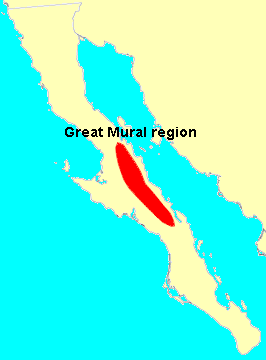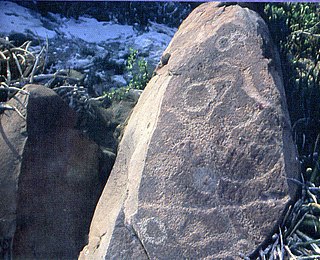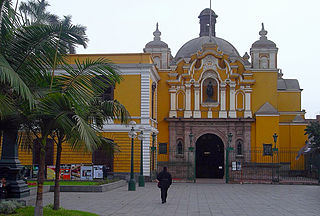
A petroglyph is an image created by removing part of a rock surface by incising, picking, carving, or abrading, as a form of rock art. Outside North America, scholars often use terms such as "carving", "engraving", or other descriptions of the technique to refer to such images. Petroglyphs, estimated to be 20,000 years old are classified as protected monuments and have been added to the tentative list of UNESCO's World Heritage Sites. Petroglyphs are found worldwide, and are often associated with prehistoric peoples. The word comes from the Greek prefix petro-, from πέτρα petra meaning "stone", and γλύφω glýphō meaning "carve", and was originally coined in French as pétroglyphe.

Cup and ring marks or cup marks are a form of prehistoric art found in the Atlantic seaboard of Europe (Ireland, Wales, Northern England, Scotland, France, Portugal, and Spain – and in Mediterranean Europe – Italy, Azerbaijan and Greece, as well as in Scandinavia and in Switzerland.

In archaeology, rock art is human-made markings placed on natural surfaces, typically vertical stone surfaces. A high proportion of surviving historic and prehistoric rock art is found in caves or partly enclosed rock shelters; this type also may be called cave art or parietal art. A global phenomenon, rock art is found in many culturally diverse regions of the world. It has been produced in many contexts throughout human history. In terms of technique, the four main groups are:
Toquepala Caves are located near Toquepala mine, about 154 km (96 mi) from the city of Tacna, in the extreme southeast of Peru. They are notable for a number of rock paintings. The best known of them is the cave named Abrigo del Diablo.

Great Mural Rock Art consists of prehistoric paintings of humans and other animals, often larger than life-size, on the walls and ceilings of natural rock shelters in the mountains of northern Baja California Sur and southern Baja California, Mexico. This group of monuments comprises the site Rock Paintings of Sierra de San Francisco, which is included on the UNESCO World Heritage List.
Prehistoric Rock Art Sites in the Côa Valley and Siega Verde are a United Nations Educational, Scientific and Cultural Organization (UNESCO) transboundary World Heritage Site, located in the Côa Valley of Portugal and Siega Verde, Spain.

Piedras del Tunjo is an important archaeological park established on a natural rock shelter 40 kilometres (25 mi) west of Bogotá in the municipality of Facatativá.

The rock drawings in Valcamonica are located in the Province of Brescia, Italy, and constitute the largest collections of prehistoric petroglyphs in the world. The collection was recognized by UNESCO in 1979 and was Italy's first recognized World Heritage Site. UNESCO has formally recognized more than 140,000 figures and symbols, but new discoveries have increased the number of catalogued incisions to between 200,000 and 300,000. The petroglyphs are spread on all surfaces of the valley, but concentrated in the areas of Darfo Boario Terme, Capo di Ponte, Nadro, Cimbergo and Paspardo.
Association des Amis de l'Art Rupestre Saharien is a French scientific organisation focusing on the rock art of the Sahara. It was established in 1991.

The Roca dels Moros or Caves of El Cogul is a rock shelter containing paintings of prehistoric Levantine rock art and Iberian schematic art. The site is in El Cogul, in the autonomous community of Catalonia, Spain. Since 1998 the paintings have been protected as part of the Rock art of the Iberian Mediterranean Basin, a UNESCO World Heritage Site. Inscriptions in Northeastern Iberian script and in Latin alphabet indicate that the place was used as a sanctuary into Iberian and Roman times.

Boca de Potrerillos is an archeological site located some 14 km from the municipal head of Mina, Nuevo León, México. About 60 km north east from Monterrey within the inter-sierra valleys of the Sierra Madre Oriental is the “mouth” or entrance to the Potrerillos Canyon between the Zorra and Antrisco hills. The site covers an area of about 6 km².
Cueva Ahumada is an archaeological site located within several canyons in the village of La Rinconada, García Municipality, in the Mexican state of Nuevo León. Cave painting in northeastern Mexico covers two types of artwork: rock engraving, also called petroglyphs. A third type of rock art, geoglyphs so far has not been detected in this region.
The Prehistoric Rock-Art Site Pala Pinta is a Paleolithic-era rock-art site, recognized for cave paintings in the Portuguese municipality of Alijó, in the civil parish of Carlão e Amieiro.

The Tito Bustillo Cave is a prehistoric rock shelter located in the small town of Ribadesella, in the autonomous community of Asturias, Spain. The cave was inhabited by humans (cro-magnon) before the year 10,000 BC. Due to the collapse of the rock, the original entrance to the cave was sealed thousands of years ago, which made it possible for preservation of objects, tools and wall paintings that were discovered in 1968. Based on those objects found in the cave, it is known that there was a significant human presence during the Magdalenian culture of the Upper Palaeolithic, but the cave was probably inhabited before that time.

Eliécer Silva Celis was a Colombian anthropologist, archaeologist, professor and writer. He is considered a pioneer in the anthropology of Colombia. Silva Celis is known in Colombia for the reconstruction of the Sun Temple, the most important temple of the Muisca religion.

This article describes the art produced by the Muisca. The Muisca established one of the four grand civilisations of the pre-Columbian Americas on the Altiplano Cundiboyacense in present-day central Colombia. Their various forms of art have been described in detail and include pottery, textiles, body art, hieroglyphs and rock art. While their architecture was modest compared to the Inca, Aztec and Maya civilisations, the Muisca are best known for their skilled goldworking. The Museo del Oro in the Colombian capital Bogotá houses the biggest collection of golden objects in the world, from various Colombian cultures including the Muisca.

The Casona of the National University of San Marcos, also known as the Cultural Centre of San Marcos, which operates in the building, is a large Spanish colonial building that hosts the cultural centre of the National University of San Marcos, located in the Historic Centre of Lima, Peru. The building, as well as its adjacent public space, known as the University Park, is part of the area and of the list of buildings of the Historic Center of Lima that were recognized as a World Heritage Site by UNESCO, in 1988.

Carlos Joaquín Gradin, also known as Carlos Gradín, was an Argentine surveyor and archaeologist. He carried out numerous studies in the Patagonian region, and is known for his extensive studies of Cueva de las Manos. He was a member of the National Scientific and Technical Research Council (CONICET).